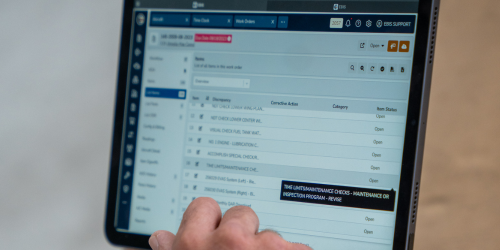
Aircraft Maintenance Software Buyer's Guide
Purpose of the Guide
Welcome to the Aircraft Maintenance Software Buyer's Guide, your comprehensive resource for understanding and navigating the world of aircraft maintenance management software. In this guide, we aim to provide a clear and insightful overview of the importance of such software, why it is essential for the aviation industry, and how to make informed decisions when selecting the right solution for your specific needs. Whether you are a seasoned aviation professional or someone new to the intricacies of aircraft maintenance, this guide will serve as a valuable tool to help you make well-informed choices and optimize the efficiency and safety of your operations.



The Aviation Industry's Growing Need for Effective Maintenance Management
Proper aircraft maintenance management is critical for ensuring efficiency, safety, reliability, and compliance when stringent regulations are paramount.
The importance of selecting the right Aircraft Maintenance Management Software, whether you are a a 1-2 man AOG truck or a multi-location operation cannot be overstated. It acts as a central nervous system for maintenance businesses, organizations and operators by streamlining, automating, and enhancing maintenance processes. This software not only helps minimize aircraft downtime but also optimizes resources, reduces operational costs, and ensures that all maintenance activities are carried out in accordance with regulatory requirements. As aircraft technology becomes increasingly complex, maintenance software has evolved to meet these challenges head-on. It integrates data, schedules, and compliance tracking, creating a digital ecosystem that empowers operators to make data-driven decisions, mitigate risks, and enhance the overall operational efficiency and safety of their fleets. The aviation industry is a dynamic and highly regulated field where the stakes are exceptionally high. It encompasses an extensive range of aircraft, from small private planes to large commercial airliners, each with unique maintenance requirements. With aviation's global nature and the continuous advancement of technology, the need for effective maintenance management is ever-increasing.

Regulatory agencies such as the Federal Aviation Administration (FAA) and the European Union Aviation Safety Agency (EASA) impose strict guidelines to ensure the airworthiness of aircraft, making compliance a non-negotiable aspect of maintenance operations. This guide delves into the specific challenges the aviation industry faces concerning maintenance management and highlights the key features and functionalities that top-tier aircraft maintenance software solutions offer to address these issues. Whether you're looking to streamline maintenance operations, improve safety, or boost the bottom line, this guide will help you make the right decision when selecting the ideal solution for your small or large business needs.
Unlocking the Power of Aircraft Maintenance Management Software
-
Maintenance Scheduling: Software should provide the ability to create and manage maintenance schedules, ensuring that routine inspections and servicing are conducted at the appropriate times. This helps prevent downtime and ensures aircraft are always airworthy.
-
Inventory and Parts Management: The software enables efficient management of spare parts and tools, ensuring that required components are available when needed, reducing delays in maintenance tasks. Capabilities might also include over-the-counter parts sales, purchase order management, etc.
-
Work or Repair Order Management: Software streamlines the creation, tracking, and assignment of work orders, ensuring that maintenance tasks are executed effectively and reported accurately.
-
Regulatory Compliance Management: Compliance with industry regulations is paramount in aviation. Solutions integrate regulatory requirements into its workflows, helping organizations adhere to standards set by authorities like the FAA and EASA.
-
Data Analysis and Reporting: The software gathers and analyzes data from various sources, offering insights into maintenance trends, performance metrics, and cost analysis.

Why Invest in Optimal Aircraft Maintenance Software Solutions?
The key functionalities and benefits of the solution are multifaceted. First and foremost, this software contributes to the safety and airworthiness of aircraft, as it ensures that maintenance activities are carried out meticulously and on schedule. By providing real-time data and analytics, it empowers aviation professionals to make informed decisions, identify potential issues before they become critical, and optimize maintenance processes. This results in reduced downtime, cost savings, and enhanced operational efficiency.
In addition to these core advantages, these solutions offer benefits such as streamlined communication among maintenance teams, improved collaboration, and enhanced documentation and reporting capabilities, all of which contribute to a more organized and efficient maintenance environment.

The software is not an isolated solution; it may be able to integrate with other systems commonly used in aviation, including Enterprise Resource Planning (ERP) software, flight planning, accounting solutions, and aircraft health monitoring systems. These integrations enhance data flow and communication across different facets of an aviation operation, allowing for a more holistic approach to maintenance management. By integrating with other systems, your aircraft maintenance management software becomes a central data hub, ensuring that critical maintenance data is accessible where and when it's needed, ultimately optimizing the entire aviation ecosystem.
Identifying Organizational Needs and Objectives
Before embarking on the journey of selecting the right Aircraft Maintenance Management Software for your organization, it is imperative to thoroughly assess your unique requirements. This section of the buyer's guide focuses on the critical considerations that will shape your choice, ensuring that the software aligns seamlessly with your organizational needs, scale of operations, and regulatory compliance obligations.
Understanding your organizational needs and objectives is the foundational step in selecting the most suitable solution. Start by engaging key stakeholders, such as maintenance personnel, operations managers, and IT professionals, to gather their input. Assess the specific challenges you aim to address with the software, whether it's reducing maintenance downtime, improving resource allocation, or enhancing safety records. Clear objectives will guide you in identifying the features and functionalities essential for your operation.
Moreover, consider your growth ambitions. Ensure that the chosen software is flexible enough to accommodate your evolving needs, keeping your long-term objectives in mind. Whether you operate a small regional airline or a global fleet, the right software solution should be adaptable and scalable to meet your changing requirements.

Determining the Size and Scale of Your Operation
The size and scale of your operation play a pivotal role in choosing the appropriate solution. For smaller operations, a simpler and cost-effective solution may suffice, focusing primarily on basic maintenance management tasks. Conversely, larger organizations with extensive fleets and multiple facilities may require a more comprehensive and feature-rich system to manage their complex maintenance needs.
Consider the number of aircraft in your fleet, the number of maintenance personnel, and the geographical spread of your operation. A holistic view of your organization's scale will aid in selecting a software solution that streamlines your maintenance operations without unnecessary complexities.
Compliance and Regulatory Requirements
Compliance with aviation regulations is non-negotiable. Depending on your geographic location and the type of aircraft you operate, you may be subject to various regulatory frameworks, such as Part 145 in the United States or 8150s in Europe. These regulations outline stringent requirements for the maintenance, repair, and documentation of aircraft.
Your solution should not only ensure compliance with these regulations but also simplify the process of record-keeping and reporting. Evaluate the software's capabilities in tracking and documenting compliance-related data, as this is crucial for audits and safety inspections.
In conclusion, a meticulous assessment of your requirements is the cornerstone of a successful selection process. By identifying specific business needs and objectives, understanding the size and scale of your operation, and ensuring compliance with regulatory requirements, you lay a solid foundation for making an informed decision that will elevate the efficiency and safety of your aircraft maintenance practices.
What are the typical features of aircraft maintenance management software?
Aircraft maintenance software is designed to help aviation organizations manage their maintenance operations efficiently. Some of the key features of aviation maintenance software include:
Work & Repair Order Management
The software should be able to generate, track and manage work orders and/or repair orders (if required) for maintenance tasks. Evaluate the details of a solution and how it enables what may be impactful to your maintenance shop. Some questions you may ask could include:
- Is a technician able to easily find the work assigned to them?
- Is warranty work handled and managed within the system?
- Is labor and time is tracked and reported on?
- Is work signed off on and approved?
- Is work is assigned, allocated to a department, etc?
- Is the status of work and where it is within the maintenance workflow?
- Do Directors of Maintenance have sufficient visibility to intervene where necessary, such as in the case where estimated hours are exceeded?
- Can 8130's get issued from repair orders?
Parts & Inventory Management
The software should be able to manage inventory levels and track the availability of parts and supplies. Some example questions you may ask:- What's the workflow on how techs can request parts?
- How can the parts person can easily order, receive, etc?
- Will we know the status of PO's and how techs are aware on status of parts?
- Can you see the use of normal parts vs serialized parts?
- Can you capture stock info and how parts get marked up?
- Are there features that enable selling parts over-the-counter?
- Does it provide the ability to conduct physical inventory audits?
- Are there AOG friendly features such as maintaining stock on the truck and managing inventory that is both physically in the hangar and on mobile trucks?
- Can you maintain multiple stock rooms?
Compliance Management
The solution should ensure adherence to FAA/EASA regulations, enhancing safety and reliability in aircraft maintenance operations. Some example questions to ask include:
- Can the software track and ensure compliance with regulatory requirements such as FAA regulations?
- Can it generate log books, print labels in different formats, etc?
- Can the provider advise on how to update a repair station manual?
Maintenance Planning
- Can the solution keep track of of trainings, inspections, vacations, etc. in a single place within a calendar and agenda view.
- Can the solution schedule maintenance tasks and track their completion?
Task Tracking
- Can the software track the progress of maintenance tasks and alert maintenance personnel when tasks are overdue?
- Are there Kanban boards to support visualizing the progress of work?
Business Performance & Data Analytics
- Can the software generate reports and provide insights into maintenance performance?
- Are dashboards easy to access and read?
- Do dashboards provide actionable insights on work-in-progress, technician efficiency and business revenue performance?
- Do dashboards provide insight on cash opportunities, etc?
- Do you have the ability to quickly determine profitability and the source of potential margin losses, i.e. via improper estimation of labor hours, parts pricing/markup rules, warranty, etc?
Mobile Accessibility
- Is the software accessible via mobile devices, allowing maintenance personnel to view and update tasks on the go?
- Is the mobile experience limited to certain devices? Is it easy-to-use?
- Are there time-saving features for technicians managing work orders and would they enjoy the experience?
Integration with other systems
- Can the software integrate with other systems such as ERP, CRM, and financial management systems?
- Do integrations require 3rd party middleware, and additional costs?
- Is there an Open API?
- Does the provider have integration partners to assist in connecting to systems?
- Are integrations configurable within the system?
User-Friendly Interface
- Is the software easy to use and navigate, with an intuitive interface?
- Is it easy to use on mobile devices including tablets and phones?
- How many clicks does it take to do [this step]?
Security
- Is the software secure, with appropriate access controls and data encryption to protect sensitive information?
- Where is data stored and maintained?
Ad Hoc Maintenance Tracking
- Can the software record and track unscheduled maintenance events, including discrepancies, defects, and emergency repairs?
- Can the software ensure timely response and resolution of these issues to minimize aircraft downtime?
Compliance Monitoring
- Can the software monitor and ensure compliance with aviation regulations, airworthiness directives, and service bulletins?
- Can the solution automatically generate work orders for compliance-related tasks?
Task Prioritization
- Can the solution help prioritize maintenance tasks based on safety, regulatory requirements, aircraft operational needs, and criticality?
- Can the software ensure that high-priority tasks are addressed promptly?
Task Assignment and Resource Allocation
- Will it assign tasks to maintenance personnel based on qualifications, availability, and workload.
- Can you allocate necessary resources, including parts, tools, and facilities, for each task?
Progress Tracking
- Can you track the progress of each maintenance task, from initiation to completion?
- Will the solution send real-time updates on task status, including work in progress, completed, or delayed tasks?
Alerts and Notifications
- Does the solution send automated notifications and alerts to maintenance teams, supervisors, and relevant personnel regarding task assignments, deadlines, and status changes?
- Can it notify stakeholders of any deviations from the maintenance plan.
Documentation Management
- Can the solution provide the ability to capture and store all relevant documentation, including maintenance manuals, service records, and compliance records?
- Can you link documentation to specific tasks for easy reference and auditing.
Electronic Logbooks
- Can you maintain electronic logbooks for each aircraft, recording all maintenance activities and their associated tasks?
- Can you provide a historical record of maintenance performed on the aircraft?
Task History and Reporting
- Can you generate reports on completed maintenance tasks, task history, and aircraft maintenance records for regulatory compliance and auditing purposes?
- Are you able to analyze maintenance data to identify trends and optimize maintenance processes?
Barcode/QR Code Scanning
- Can you utilize barcode or QR code scanning to streamline task tracking and parts inventory management?
Integration with Inventory Management
- Can you ensure that required parts are available when needed for maintenance tasks?
Mobile Accessibility
- Does the solution provide mobile access to task tracking capabilities, enabling maintenance personnel to update task status, complete checklists, and access documentation in the field?
Customization and Configurability
- Can you manage and customize user profiles, city options, billing & tax profiles, job scheduling, category profiles, certifications, etc?
- Can you create a specialized lists of categories, sub-categories and action categories?
Finding the right solution provider.
Selecting the right Aircraft Maintenance Management Software vendor is a pivotal step in the process of acquiring an effective maintenance management solution. In this section, we'll explore the critical aspects of conducting market research, identifying reputable vendors and software options, requesting demos and trials, and obtaining references and case studies to make an informed choice.
✅ Market Research and Industry Analysis
Start your vendor selection process with comprehensive market research and industry analysis. Understanding the landscape of aircraft maintenance software providers and industry trends is vital. You should be aware of the latest developments in aircraft software technology, pricing models, and the reputations of different vendors in the aviation sector. Stay informed about industry benchmarks and emerging best practices. This knowledge will serve as the foundation for your vendor selection criteria.
✅ Identifying Reputable Vendors and Software Options
Identifying reputable vendors is crucial for ensuring the reliability and effectiveness of your software solution. Begin by creating a shortlist of potential vendors based on your research. Consider factors such as the vendor's track record in the aviation industry, the range of software options they offer, and whether their solutions align with your organization's requirements and objectives. Evaluate customer reviews, ratings, and feedback to gauge user satisfaction and the vendor's commitment to customer support.
Consider whether the solution provider is purpose-built for aviation or attempting to be more generic and work across verticals, and how that might impact your decision. Will generic solutions require unseen costs to customize to fit your needs?
✅ Requesting Demos and Trials
Once you have a shortlist of potential vendors and software options, request demos and trials to gain a firsthand understanding of how their systems operate. Demos allow you to explore the software's user interface, features, and functionalities. Trials, if available, enable your team to use the software in a real-world context. During this evaluation phase, pay attention to user-friendliness, customization options, reporting capabilities, and integration with other systems. Assess how well the software aligns with your operational needs and objectives.
✅ Obtaining References and Case Studies
To gain deeper insights into the performance and reliability of a solution and its vendor, request references and case studies from the vendor. These resources can provide you with real-world examples of the software's impact on similar organizations. Speak to existing customers to understand their experiences with the vendor's support, the software's scalability, and its ability to meet specific needs. Case studies showcase success stories and demonstrate how the software has improved maintenance operations in different scenarios.
In conclusion, the vendor research and selection phase is a critical element in acquiring the right aircraft maintenance software. Through market research, identifying reputable vendors, requesting demos and trials, and obtaining references and case studies, you can make an informed choice that aligns with your organization's goals, ensuring a successful implementation of the software to enhance the efficiency and safety of your aircraft maintenance operations.
Evaluating Software Flexibility and Customization Options
When investing in Aircraft Maintenance Management Software, ensuring that the software can adapt to your specific needs and scale with your organization's growth is paramount. In this section, we'll explore the importance of evaluating the software's flexibility, customization options, and its ability to grow with your organization.
Evaluating Software Flexibility and Customization Options
No two aviation operations are identical, which is why the flexibility and customization capabilities of your chosen software are essential. During the selection process, evaluate the software's adaptability to your unique workflows and operational requirements. Look for features that allow you to configure the system to align with your existing processes. The ability to customize data fields, forms, and reports ensures that the software caters to your specific maintenance procedures.
Furthermore, consider how the software handles integrations with other systems and third-party applications. A flexible solution should support various data exchange formats, APIs, and offer compatibility with other tools, enabling you to build a cohesive digital ecosystem that streamlines your maintenance operations.
Assessing the Ability to Scale with Organizational Growth
As your organization expands or experiences changes, your solution must be capable of scaling accordingly. Whether you plan to grow your fleet, open new maintenance facilities, or diversify your operations, your software should be able to accommodate these developments seamlessly. The scalability of the solution is crucial for preventing disruptions in your maintenance operations during periods of growth.
Evaluate whether the software can handle a larger number of aircraft, users, and data without compromising performance. Consider the associated costs and licensing structures to ensure that scaling your software does not become prohibitively expensive as your organization evolves.
Additionally, a scalable aircraft maintenance management system should offer support for multi-location or multi-facility management, enabling you to maintain centralized control while accommodating the demands of a growing and geographically dispersed operation.
In conclusion, the customization and scalability of your chosen solution play a pivotal role in its long-term effectiveness and value to your organization. The ability to tailor the software to your unique processes and ensure it can grow with your organization is instrumental in guaranteeing that your maintenance management system remains a vital asset as your aviation operation evolves and expands.
It's crucial to ask detailed and specific questions to ensure that the software meets your organization's needs. Here is a list of questions that you can use as a starting point:
Company Information
- Can you provide an overview of your company, including its history, size, and any relevant certifications?
- What is your experience in developing aircraft maintenance software
Software Features and Capabilities
Please describe the key features and capabilities of your aircraft maintenance software.
- How does your software support different types of aircraft, including fixed-wing and rotorcraft?
- Can the software handle maintenance scheduling, work order management, and tracking of maintenance histories
- Does the software support compliance with relevant aviation regulations and standards (e.g., FAA, EASA, etc.)?
- What tools are available for managing spare parts inventory and procurement?
User Interface and Ease of Use
- How user-friendly is your software, and what steps have you taken to ensure a smooth user experience?
- Is the software accessible via mobile devices for field use and inspections?
Integration and Compatibility
- Does your software integrate with other commonly used aviation systems, such as maintenance tracking systems or financial software?
- Can it import data from existing systems or databases such as CAMP, Traxall, etc?
Data Security and Compliance
- What measures do you have in place to ensure data security and compliance with relevant data protection regulations (e.g., GDPR)?
- Are regular security audits and updates conducted on the software?
Technical Support and Training
- What support and training options do you offer to assist users in implementing and using the software effectively?
Scalability
- How scalable is your software to accommodate the growth of our aircraft fleet and maintenance operations?
Cost and Pricing
- What is your pricing structure, and are there any ongoing maintenance or licensing fees?
- Are there any additional costs for training, support, or software updates
- What is your pricing model? Do you charge for value-driving users like technicians?
References
- Can you provide references from other aviation organizations that have used your software?
- Have you successfully implemented your software in organizations of a similar size and complexity to ours
Implementation Timeline
- What is the expected timeline for software implementation from the point of contract signing to full deployment?
Service Level Agreements (SLAs)
- Do you offer SLAs for system uptime, response times for support, and resolution of issues?
Maintenance and Updates
- How often do you release software updates, and what is the process for implementing them?
Data Migration
- Do you offer assistance with migrating data from our existing systems to your software?
Disaster Recovery and Backup
- What provisions do you have in place for data backup and disaster recovery in case of system failures or data loss?
Terms and Conditions
- Are there any specific terms and conditions, including termination clauses, that we should be aware of in your proposal?
Demo and Trial
- Can you provide a demonstration of your software, or is a trial period available for our team to evaluate its functionality?
Ensuring Compatibility with Existing Systems
A crucial aspect of selecting the right Aircraft Maintenance Management Software is ensuring that it seamlessly integrates with your existing systems. Incompatible software can lead to inefficiencies, data silos, and a fragmented workflow. To ensure compatibility, you should:
- Conduct a System Inventory: Start by cataloging all the software tools and systems your organization currently uses. This includes Enterprise Resource Planning (ERP) systems, flight planning solutions, financial software, and any other applications crucial to your operations.
- Identify Data Sharing Needs: Determine the data flow requirements between your existing systems and the proposed solution. Consider what information needs to be shared, such as maintenance records, inventory data, and flight schedules.
- Assess Data Formats and Protocols: Different software applications may use various data formats and communication protocols. Evaluate whether the solution can accommodate these formats and protocols. Common standards like XML or JSON facilitate data exchange between systems.
- Ensure API Compatibility: Application Programming Interfaces (APIs) play a pivotal role in software integration. Verify that the solution offers APIs that can connect with your existing systems. Check if the vendor provides documentation on API endpoints and data structure to facilitate integration.
- Collaborate with IT Experts: Collaborate with your organization's IT experts to ensure a seamless integration process. They can offer insights into the technical aspects of data exchange and assist in evaluating the compatibility of the solution with your existing infrastructure.
Evaluating Integration Capabilities with Third-Party Tools and Software
In today's digital ecosystem, aviation operations rely on a wide array of third-party tools and software for various functions. Your solution should not exist in isolation but should have the capability to integrate with these tools to enhance your operational efficiency. When evaluating integration capabilities, consider the following:
- Third-Party Ecosystem: Assess whether the software vendor has a robust ecosystem of third-party integrations or partnerships. This can include connections to software for weather tracking, regulatory compliance, flight planning, or even financial management.
- API Availability: As mentioned earlier, APIs are a vital component for third-party integrations. Ensure that the platform provides well-documented and accessible APIs for integrating with other industry-specific software.
- Custom Integration Options: In cases where a predefined integration isn't available, check if the software offers custom integration options. This allows your organization to develop tailored connections to the specific tools you need.
- Data Security and Compliance: Be mindful of data security and compliance when integrating with third-party tools. Ensure that the solution has robust security measures in place to protect sensitive data shared with other applications.
By ensuring compatibility with your existing systems and evaluating integration capabilities with third-party tools, you can create a cohesive and efficient digital ecosystem that optimizes your aircraft maintenance operations and enhances the overall productivity and safety of your aviation business.
Navigating the Implementation Process
Implementing new Aircraft Maintenance Management Software is a critical process that requires meticulous planning and execution. Whether you're migrating from existing solutions or implementing the solution for the first time, it's essential to consider various factors to ensure a smooth transition. Here's a detailed guide on the implementation process and the key questions to ask solution providers:
Migration from Existing Solutions: If you are transitioning from legacy systems or other maintenance management software, inquire about the migration process. Understand how the solution provider handles data transfer, ensuring a seamless transition of historical records, maintenance schedules, and other critical information. Clarify the timeline, potential downtime, and contingency plans for data integrity during migration.
Questions for Solution Providers:
- Implementation Timeline: What is the estimated timeline for the entire implementation process, from initial setup to full integration and go-live?
- Data Migration: How does the solution provider ensure a smooth transition of data from existing systems? Can they provide examples or case studies of successful migrations?
- Training Programs: What training resources and programs does the solution provider offer to ensure the team is well-equipped to use the new solution efficiently?
- Technical Support: What level of technical support is available during the implementation phase? How quickly can the provider address any issues or challenges that may arise?
Integrations and Integration Partners: Consider the integrations necessary for seamless connectivity with other aviation systems, such as Enterprise Resource Planning (ERP) software, maintenance tracking tools, or accounting solutions. Ask solution providers about their existing integration capabilities and partnerships. A robust ecosystem of integration partners enhances the overall functionality and adaptability of the solution.
Support Throughout the Process: Understand how the solution provider supports you throughout the implementation journey. This includes assistance with system configuration, troubleshooting, and addressing any customization requirements. Clear communication channels and responsive support contribute significantly to a successful implementation.
Internal Change Management: Recognize the impact of the new software on your organization's processes and workflows. Develop a change management strategy to ensure smooth internal adoption. This involves effective communication, training programs, and addressing concerns or resistance from team members. A well-managed change process enhances user acceptance and minimizes disruptions.
Training and Knowledge Transfer: Inquire about the training programs provided by the solution provider. A comprehensive training plan should cover administrators, end-users, and any other stakeholders involved in the maintenance management process. Knowledge transfer ensures that your team can fully utilize the capabilities of the solution.
Continuous Improvement and Feedback: Establish a feedback loop with the solution provider to address any issues that may arise post-implementation. A commitment to continuous improvement ensures that the software evolves to meet your changing needs and remains aligned with industry best practices.
In conclusion, a successful implementation of Aircraft Maintenance Management Software involves careful consideration of migration processes, questions for solution providers, integration capabilities, ongoing support, internal change management, and a commitment to continuous improvement. By addressing these aspects proactively, your organization can maximize the benefits of the new solution and elevate the efficiency of aircraft maintenance operations.
Setting Up Your Migration or Implementation for Success
Implementing an Aircraft Maintenance Management Software solution is a substantial undertaking that requires careful planning and effective project management. Here are key considerations:
- Project Scope and Objectives: Clearly define the scope of the implementation, along with the specific objectives you aim to achieve. This should include the features and functionalities you plan to utilize, as well as any customization or integration requirements.
- Project Team: Assemble a dedicated project team with representatives from various departments, including maintenance, IT, and management. Define roles and responsibilities within the team and appoint a project manager to oversee the implementation.
- Timeline and Milestones: Develop a realistic timeline with clear milestones. Ensure that you allocate sufficient time for each phase of the implementation process to avoid rushed or haphazard deployments.
- Resource Allocation: Adequately allocate resources, both human and financial, to the project. This includes budgeting for potential unforeseen expenses and dedicating personnel to the implementation effort.
- Risk Assessment: Identify potential risks and develop strategies for mitigating them. Factors like data loss during migration, software compatibility issues, or resistance to change should be considered and addressed proactively.
Data Migration and System Setup
Efficient data migration and system setup are critical for a smooth transition to your new solution:
- Data Assessment: Assess the quality and completeness of your existing data. Clean and organize your data to ensure a seamless migration process. This includes aircraft maintenance records, inventory data, and compliance documentation.
- Migration Strategy: Develop a data migration strategy that outlines the specific steps, data formats, and tools required to transfer data from your legacy systems to the new system. Test the migration process with a subset of data to ensure accuracy.
- System Configuration: Set up the software according to your defined requirements. This includes customizing the software to align with your maintenance workflows, configuring user roles and permissions, and integrating with other systems as needed.
- Testing and Quality Assurance: Thoroughly test the system for functionality, data accuracy, and user experience. Ensure that any issues or discrepancies are addressed before moving forward.
Training and Change Management Strategies
Effective training and change management are essential for user adoption and success:
- Training Plans: Develop comprehensive training plans that encompass all user levels, from technicians to management. Consider on-site training, webinars, documentation, and video tutorials to accommodate diverse learning styles.
- Change Management: Implement change management strategies to ease the transition for employees. Communicate the benefits of the new system, address concerns, and establish a support system for users encountering difficulties during the initial stages of adoption.
- Continuous Support: Offer ongoing support and assistance to users as they adapt to the new system. Provide avenues for feedback and improvements, and ensure that users have access to the necessary resources to troubleshoot issues.
By paying careful attention to the planning and project management, data migration and system setup, and training and change management strategies, you can ensure a successful implementation of your maintenance solution. This will result in improved efficiency, enhanced safety, and better compliance with regulatory standards in your aircraft maintenance operations.
Establishing a Realistic Budget
Creating a realistic budget for the implementation of Aircraft Maintenance Management Software is a foundational step that ensures the successful adoption of the system without unexpected financial burdens. To establish a realistic budget:
- Identify Expenses: Begin by identifying all potential expenses related to the acquisition and implementation of the solution. This includes software licensing, hardware requirements, data migration, training, customization, and ongoing support.
- Consult with Vendors: Engage with aircraft maintenance software vendors to gain a clear understanding of their pricing structures and any associated costs. Vendors can help you comprehend the total cost of ownership, including both upfront and long-term expenses.
- Account for Contingencies: Plan for unforeseen expenses or potential delays in the implementation process. Allocating a contingency budget can help you manage unexpected costs without derailing the project.
- ROI Assessment: Consider the return on investment (ROI) that the solution will provide. Evaluate the anticipated cost savings, improved operational efficiency, and enhanced safety records to justify the budget allocation.
Understanding Licensing Models and Pricing Structures
Aircraft maintenance software vendors typically offer various licensing models and pricing structures. Understanding these models is crucial in budgeting and cost analysis:
Subscription vs. Perpetual License: Many vendors provide subscription-based licensing models, where you pay on a recurring basis, often monthly or annually. Alternatively, some offer perpetual licenses with a one-time upfront fee. Consider which model aligns with your budget and long-term financial strategy.
User-Based vs. Aircraft-Based Licensing: Some vendors charge based on the number of users, while others base their pricing on the number of aircraft or modules you require. Ensure you select a licensing model that reflects your specific usage needs.
Additional Costs: Be aware of any additional costs, such as fees for data storage, integration with other systems, or customization. These costs can significantly impact the overall budget.
Factoring in Ongoing Maintenance and Support Costs
It's important to recognize that the cost of the solution extends beyond the initial acquisition. Ongoing maintenance and support are integral aspects of the software's lifecycle:
Maintenance and Updates: Regular maintenance and software updates are essential to ensure the solution remains current and secure. Inquire about the costs associated with these updates and whether they are included in the subscription fee.
Support Services: Consider the level of support services offered by the vendor. Evaluate their responsiveness to technical issues, their availability for troubleshooting, and any associated support fees.
Training Costs: Continuous training for new employees or to stay updated on software features is often necessary. Budget for training to keep your staff proficient in using the solution effectively.
By establishing a realistic budget, understanding licensing models and pricing structures, and factoring in ongoing maintenance and support costs, you can make an informed financial plan for your software acquisition. This ensures that your investment in the software not only aligns with your organization's financial resources but also delivers long-term value through improved operational efficiency and safety in your aircraft maintenance operations.
Assessing Data Security Measures and Protocols
When choosing Aircraft Maintenance Management Software, it is of paramount importance to assess the data security measures and protocols in place to safeguard your sensitive information. Aircraft maintenance involves a significant amount of confidential data, including maintenance records, aircraft specifications, and compliance documentation. To ensure data security:
- Encryption: Confirm that the software employs strong encryption methods to protect data both in transit and at rest. This ensures that any data stored in the system and data transferred between users is safeguarded from unauthorized access.
- Access Control: Evaluate the software's access control features. It should offer the ability to define user roles and permissions, restricting access to sensitive data to only authorized personnel. Granular control over who can view, edit, or delete data is crucial.
- Data Backups: Check if the software provides regular data backups and disaster recovery mechanisms. Data loss can be catastrophic in the aviation industry, so robust backup processes are essential for quick data restoration.
- Audit Trails: Assess whether the software maintains comprehensive audit trails that track all actions and changes made within the system. This not only helps in maintaining accountability but also aids in compliance with regulatory requirements.
- Vendor Security Practices: Inquire about the security practices and certifications of the software vendor. Reputable vendors should adhere to industry best practices and might even hold certifications like SOC 2 Type 2 Certification or ISO 27001 for information security management.
Ensuring Compliance with Industry Standards and Regulations
Compliance with industry standards and regulations is non-negotiable in aviation maintenance. It is essential that your chosen software aligns with the standards and requirements set by regulatory authorities such as the Federal Aviation Administration (FAA), the European Union Aviation Safety Agency (EASA), or the International Civil Aviation Organization (ICAO). Consider the following:
- Regulatory Adherence: Confirm that the solution is designed to support compliance with relevant aviation regulations. It should facilitate the documentation and reporting necessary to meet the stringent requirements of your industry.
- Regulatory Updates: Verify that the software is regularly updated to reflect changes in regulations. Compliance requirements can evolve, so it's crucial that the software remains current to ensure your operations are always aligned with industry standards.
- Audit and Reporting Capabilities: Ensure that the software provides robust auditing and reporting capabilities to meet audit requirements set by regulatory agencies. The ability to generate compliance reports easily is vital for inspections and audits.
- Documentation Management: Evaluate the system's capabilities for managing compliance documentation, such as airworthiness certificates, maintenance manuals, and work orders. These documents should be easily accessible, organized, and subject to version control.
Customer Support
Evaluating the Level of Customer Support Provided
The level of customer support offered by an Aircraft Maintenance Management Software vendor is a critical factor in your decision-making process. When evaluating customer support, consider the following aspects:
- Availability: Assess the availability of customer support. A reputable vendor should provide round-the-clock support to ensure that you can get assistance whenever you encounter issues, irrespective of your location or time zone.
- Responsiveness: Prompt response to queries and issues is vital. Evaluate the vendor's track record in terms of response times and resolution rates. Check for reviews and references from existing customers to gauge the quality of support.
- Support Channels: Determine the various support channels available, such as phone, email, live chat, or a dedicated support portal. Multiple support options allow you to choose the method that best suits your needs.
- Knowledge Base: A comprehensive knowledge base or user documentation can be a valuable resource for users. It should offer guides, FAQs, video tutorials, and other materials that enable users to find answers to common questions independently.
- Escalation Process: Understand the escalation process in case you encounter more complex issues that cannot be resolved at the first level of support. Knowing how and when an issue will be escalated can help manage expectations.
Understanding Available Training Resources and Options
Effective training is essential for users to make the most of the software. Consider the training resources and options offered by the vendor:
- Training Programs: Determine whether the vendor provides structured training programs, which can include on-site training, webinars, remote sessions, or in-person workshops. Training programs should cover all user levels, from technicians to management.
- Customization: Assess the extent to which training can be customized to align with your organization's specific needs. A tailored approach can be highly effective in ensuring that training is relevant and engaging.
- Documentation: User-friendly documentation, such as user manuals, guides, and video tutorials, should be available. Check the availability and comprehensiveness of these resources.
- Onboarding Process: Understand the vendor's onboarding process. A well-structured onboarding process can ease the transition to the new system and provide users with a clear understanding of its features and functionalities.
Understanding Internal User Levels
It's essential to recognize the diversity of user levels within your organization and tailor training and support accordingly:
Technicians: Technicians and maintenance personnel require hands-on training and support for executing maintenance tasks and using the software effectively in their daily work.
Supervisors and Managers: Supervisors and managers should receive training that empowers them to oversee maintenance operations, monitor compliance, and analyze data for decision-making.
IT Personnel: IT personnel are crucial for system setup, integration, and maintenance. They require in-depth training and support related to the technical aspects of the the software.
End Users: End users who interact with the software for specific tasks, such as recording maintenance data, should receive training on the software's user interface and functionalities.
By carefully evaluating the level of customer support, understanding available training resources and options, and recognizing the diverse user levels within your organization, you can ensure that users are adequately supported and well-prepared to use the the software effectively. This investment in user support and training contributes to the success of your aircraft maintenance operations and enhances overall efficiency and safety.
Finalizing vendor selection
After research and assessment, it's time to make the final decision on your Aircraft Maintenance Management Software vendor. The following steps can help ensure you finalize the best vendor selection:
- Vendor Comparisons: Review your notes and evaluations from the selection process to compare vendors objectively. Take into account factors such as the vendor's reputation, support, pricing, and their ability to meet your organization's specific needs.
- Reference Checks: Contact references provided by the vendor to gather insights from organizations that have implemented the same AMMS. Ask about their experiences, any challenges faced during implementation, and the benefits they've realized.
- Demo Feedback: Consult with your project team and end-users who participated in the software demos and trials. Their feedback can provide valuable insights into the usability and compatibility of the AMMS.
- Alignment with Objectives: Revisit your organization's objectives and requirements. Confirm that the selected vendor aligns with your goals and has the capability to address your unique needs.
- Scalability and Long-term Viability: Consider the long-term implications of your decision. Ensure that the chosen vendor's AMMS can scale with your organization's growth and remains viable for the foreseeable future.
Negotiating Terms and Contracts
Once you've selected a vendor, it's essential to negotiate terms and contracts that protect your interests and clarify expectations:
- Licensing and Pricing: Negotiate the licensing terms, including the subscription period, user limits, and pricing. Seek favorable terms that accommodate your budget and future expansion plans.
- Service Level Agreements (SLAs): Define clear SLAs that outline the level of support, response times, and system availability you can expect from the vendor. Ensure that the SLAs meet your operational requirements.
- Data Ownership and Security: Clarify data ownership and security. Specify how your data will be stored, protected, and made available in case you decide to switch vendors or terminate the contract.
- Termination Provisions: Establish provisions for contract termination, including notice periods and data retrieval procedures. These details are crucial to protect your interests in the event of unexpected circumstances.
- Customization and Integration: Define the scope of customization and integration work, including any associated costs. Ensure that the customization aligns with your specific operational needs.
Planning the Implementation Process
The implementation process is a critical phase of bringing your chosen solution into your organization. To ensure a smooth transition, it's essential to plan meticulously:
- Project Team: Confirm the roles and responsibilities of your project team and appoint a project manager. Clear leadership is crucial for coordinating all aspects of the implementation.
- Timeline and Milestones: Develop a detailed timeline with specific milestones. Ensure that you allocate sufficient time for each phase, including data migration, training, and testing.
- Data Migration Strategy: Execute your data migration strategy, transferring all relevant data from your legacy systems to the AMMS. Ensure that the process maintains data accuracy and integrity.
- Training Plan: Implement a comprehensive training plan that covers all user levels within your organization. Include onboarding for new employees and ongoing training to keep existing users proficient.
- Testing and Quality Assurance: Rigorously test the solution to verify its functionality, data accuracy, and user experience. Address any issues before moving forward with full implementation.
By taking these steps to finalize vendor selection, negotiate terms and contracts, and plan the implementation process, you can ensure that your transition to the new software is as smooth and effective as possible. This final decision-making phase marks the culmination of your efforts in acquiring the right software to enhance the efficiency, safety, and compliance of your aircraft maintenance operations.

Looking to explore a new aircraft maintenance management system?
Schedule some time with one of our experts.

